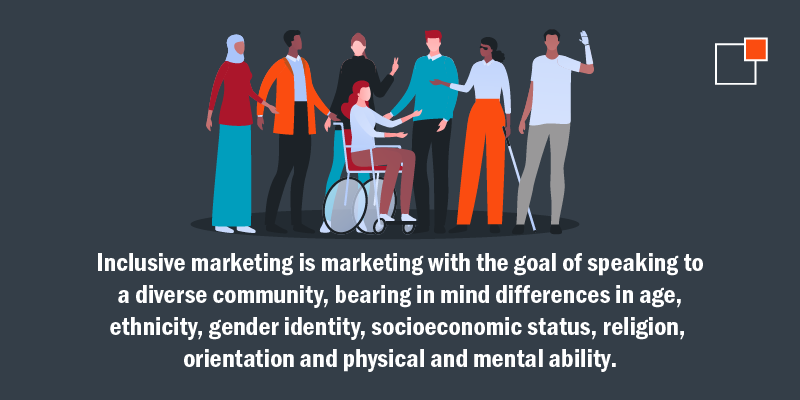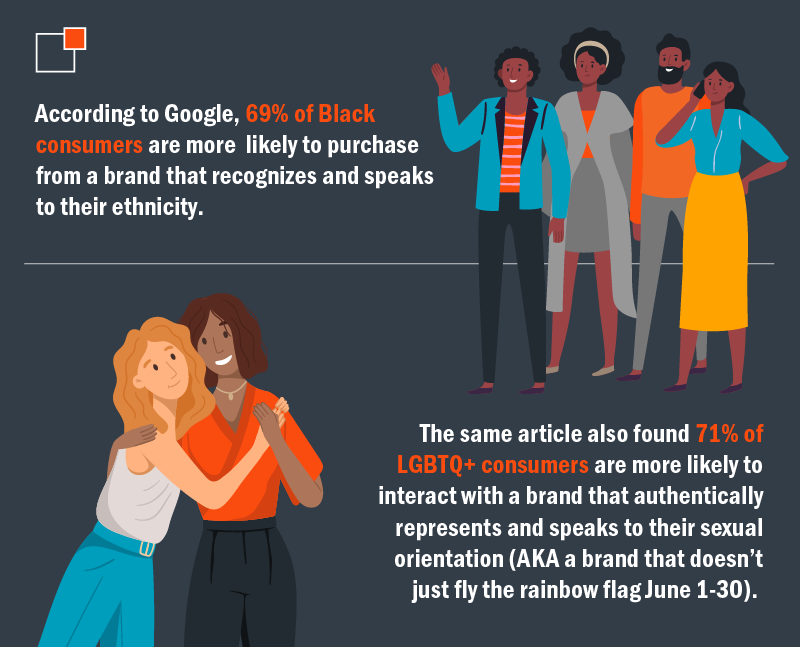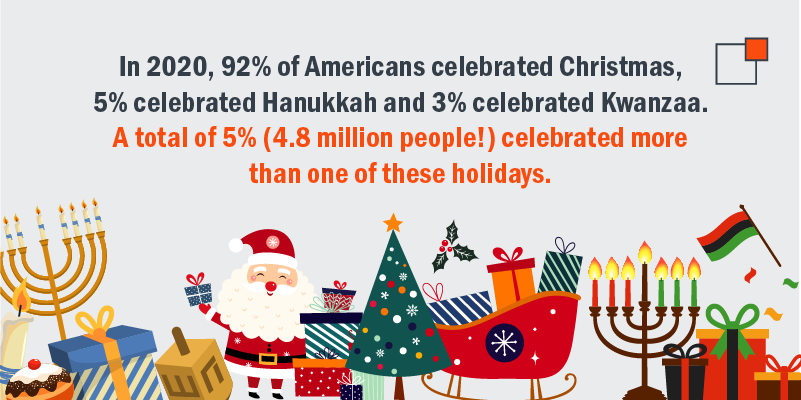Inclusivity Matters:
A Strategic Guide to Inclusive Marketing in 2022
Inclusive marketing is marketing with the goal of speaking to a diverse community, bearing in mind differences in age, ethnicity, gender identity, socioeconomic status, religion, orientation and physical and mental ability.

Audiences are becoming less and less homogenous, especially in Western nations. People want to see themselves represented in your brand and its marketing. There are two key reasons why incorporating inclusive marketing strategies is necessary for any business looking to grow and maintain a foothold within their industry.
Inclusive marketing is good for humanity
When we celebrate real people in the real world, everybody wins. In 2020, the U.S. Census Bureau found more than 42% of Americans identified as non-white, up from 36% in 2010. As our nation continues to grow and change, the Pew Research Center estimates the U.S. will not have one majority racial group by the year 2055.In fact, it’s human nature to seek out role models and characters we can relate to and empathize with. A PBS Newshour segment from 2019 spoke to 100 middle and high school-aged students about representation in the media and found minority students reported a hit to their mental health and a struggle to shape their identity when they didn’t see themselves represented in pop culture. Further, fifty eight percent of TV viewers believe the media plays a role in enforcing stereotypes, and we as marketers have an opportunity and obligation to support healthy, inclusive representation.
Inclusive marketing is good for business
According to Google, 69% of Black consumers are more likely to purchase from a brand that recognizes and speaks to their ethnicity. The same article also found 71% of LGBTQ+ consumers are more likely to interact with a brand that authentically represents and speaks to their sexual orientation (AKA a brand that doesn’t just fly the rainbow flag June 1-30).
Audiences have made it clear they’re demanding diversity in the media they consume. In 2021, UCLA released its annual diversity report dissecting the previous year’s media. The report found films where less than 11% of the cast were representative of minority groups were the ones with the lowest performance at the box office in 2020. In opposition, ticket sales were higher when more than 20% of the cast were minorities.
How to Make Your Marketing Inclusive in 2022
Any business, any size and in any industry can implement inclusive marketing strategies. Start by incorporating these key principles within your next campaign, job listing or web project.1. Accessibility is key
Digital accessibility is the practice of ensuring all persons can use a digital product, such as a website, regardless of individual abilities such as sight, hearing, cognitive, reading level and motor coordination.There are 285 million people worldwide who experience a visual impairment and this community should be able to access your website the same as others. Similarly, over 430 million people experience hearing impairments and want to enjoy the video content you worked hard to produce.
Digital accessibility includes, but is not limited to:
- Using alt text on images to describe them in words
- Selecting easy-to-read colors for creative assets, especially for visually impaired users
- Including captions in videos
- Placing form field labels outside the form field
- Choosing high contrast imagery
2. Representation matters
This one goes out to all you creative teams out there, especially those using stock imagery and video. Inclusive marketing means working to ensure your final assets are diverse and fully representative of all audiences, even when it requires more work.Most stock photo sites, widely used by creative teams, feature primarily white, able-bodied models and have limited options of all other races, sizes and abilities. Writer Nisha Mody wrote an excellent commentary on this topic, which you can read in full here.
Designers should make an effort to include BIPOC, women, different sized bodies and people with disabilities in creative assets. The images we put out into the world define what’s normal for the human brain to see and diversity should be the norm. Don’t forget to bookmark some of our favorite sites to find diverse imagery to get started!
3. Expand your holidays
Social media teams love to pounce on holiday-related content, but tend to have a hard time moving beyond U.S. and Eurocentric holidays like Fourth of July, Thanksgiving and Christmas. Consider this: In 2020, 92% of Americans celebrated Christmas, 5% celebrated Hanukkah and 3% celebrated Kwanzaa. A total of 5% celebrated more than one of these holidays. Three percent of America may seem minute, but that’s 4.8 million people!

Outside of the winter months, ask your social media team to respectfully and appropriately celebrate holidays like Juneteenth, Chinese New Year and Eid al-Fitr. A simple “Eid Mubarak!” post can go a long way in normalizing diverse cultural celebrations and making everyone on a team feel included.
4. Don’t assume your audience
Know how to properly identify and talk to your audience, rather than just assuming who they are and what they want to hear. Sneaky biases can cause us to lean into preconceived notions of gender, race and other identifiers.
The best way to avoid assumptions is to conduct individual internal work. For example, the thunder::tech team is familiar with the Harvard Implicit Association Test (IAT), which uncovers existing unconscious bias within the test taker. Using tools like this makes your implicit biases more transparent, and knowing these biases is the first step in overcoming them and preventing them from bleeding into your work.
Lastly, remember to base your buyer personas and customer profiles only in facts and reality. We talk more about this here.
5. Avoid stereotypes in advertising
Stereotypes are still rife within the world of marketing, especially when people assume they know their audience. For example, a 2021 New York Times spotlighting the authors of the book “Brandsplaining: Why Marketing is (Still) Sexist And How To Fix It” says:
“In 2019, the Geena Davis Institute on Gender in Media found that ads up for awards at the prestigious Cannes Lions advertising festival depicted male characters working almost twice as often as female characters. Male characters also outnumbered female characters two-to-one and had twice as much screen time and speaking time. Another study conducted by Ebiquity, a media consultancy, found that, of the ads aired in 2016, only 4 percent showed women in leadership positions.”
- “Yes, Marketing is Still Sexist,” The New York Times

This translates beyond women, too. Not that we encourage it, but Googling “racist ads 2021” or “offensive ads 2021” yields results that shouldn’t have made it into a brainstorm.
So if stereotypes had any basis in reality, why would huge corporations continually invest millions into customer data and research? Assumptions are often shattered when marketers examine real-life customer profiles, customer surveys and research-backed statistics. Bottom line: Stereotypes are not reality. The best way to avoid stereotyping in your marketing is to do your research and always fact check your work.
6. Use inclusive language
The American Psychological Association has a full and complete guide to inclusive language you can use as a reference, but easy swaps include
Gender neutral language (“mail person” instead of “mailman”)
Person-first language (“person without a home” instead of “homeless”)
Identity-related terms (“older person” instead of “elderly,” “wheelchair user” instead of “wheelchair-bound”)
7. Measure impact
You should still debrief internally to discuss how each campaign met your DEI goals and how you can improve for next time, but only your audience can confirm you had the right impact. Even the best intentions can land the wrong way.
Your audience will tell you if your marketing reflected their standards for DEI. If they don’t offer the information up themselves, ask them. Their feedback is key.
8. Be intentional
- Leadership quotas (ex. 50% of the executive team must be women)
- Candidate quotas (ex. 50% of interviewees must be minorities)
- Creating a diversity council internally
- Hosting regular DEI workshops for employees (you can outsource these sessions to trained professionals who will lead them for you!)
You can find other examples of DEI business goals here.
Intentionality also means talking openly about making campaigns and strategies more inclusive. Every campaign should be evaluated from an inclusive marketing lens before launch to ensure the DEI strategies above have been appropriately integrated. The more you do it, the more it becomes second nature for everyone on your team.
If you don’t have a large team, multicultural agencies and consulting firms of all sizes are available to assist. Never ask a team member from a minority group to step into your marketing meeting to evaluate your campaign or speak for the entire community they belong to. It’s up to you as the marketer and owner of the campaign to do the work.
We as marketers control what our audience sees and consumes, so inclusivity must be the norm in marketing. Consistency and deliberate actions, both big and small, are the only way we’ll see lasting, positive change in our industry.
